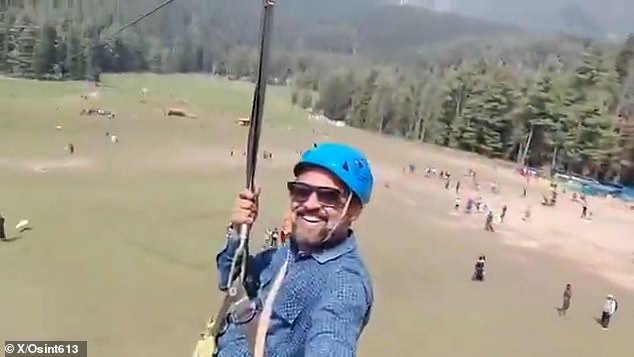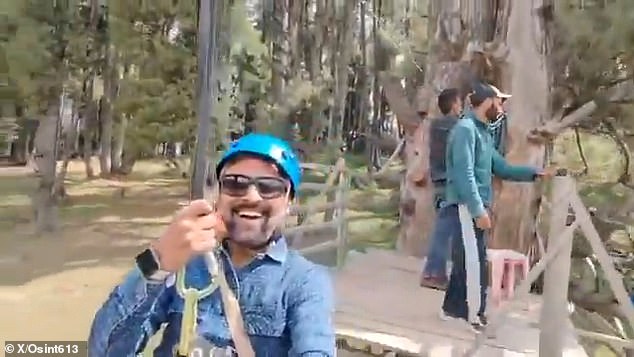By LAURA PARNABY FOR DAILYMAIL.COM
Published: | Updated:
A heart-stopping video has captured the moment a tourist zip-lined over a terror attack in India while completely oblivious to the carnage unfolding below.
Rishi Bhatt can be seen soaring over the scene of a mass shooting which killed 26 people in Pahalgam, northern India, on April 22 in the minute-long footage.
Bhatt survived the ordeal, and told local news stations that taking the zipline likely saved his life, because the terrorists took aim at tourists close to the launch point.
The jaw-dropping video shows Bhatt beaming gleefully as he flies over the hills of the Jammu and Kashmir region, where children can be seen playing on trampolines while people gather in groups.
But gunshots ring out below, and the footage turns from a fun holiday live-stream to a video chronicling a horrific moment in India’s history.
The terror attack marked a major shift in the regional conflict, because tourists had largely been spared in the bloodshed until now.
Police blamed militants fighting against Indian rule for the attack in Baisaran meadow, some 5 kilometers (3 miles) from the disputed region’s resort town of Pahalgam.
At least 36 people were wounded, many of them seriously, according to two senior police officers.



‘This attack is much larger than anything we’ve seen directed at civilians in recent years,’ Omar Abdullah, the region’s top elected official, wrote on social media.
The two officers said at least four militants fired at dozens of tourists from close range.
Most of the killed tourists were Indian, they said, speaking on condition of anonymity in keeping with departmental policy.
At at least 24 bodies were collected in the aftermath of the attack and two people died while being taken for medical treatment.
There was no immediate claim of responsibility. Police and soldiers were searching for the attackers.
‘We will come down heavily on the perpetrators with the harshest consequences,’ India’s home minister, Amit Shah, wrote on social media.


He arrived in Srinagar, the main city in Indian-controlled Kashmir, and convened a meeting with top security officials.
Indian Prime Minister Narendra Modi cut short his two-day visit to Saudi Arabia and returned to New Delhi early Wednesday, the Press Trust of India news agency said.
U.N. Secretary-General Antonio Guterres strongly condemned the attack and stressed that ‘attacks against civilians are unacceptable under any circumstances,’ U.N. spokesman Stephane Dujarric said.
Mirwaiz Umar Farooq, Kashmir’s top religious cleric, said on social media that ‘such violence is unacceptable and against the ethos of Kashmir, which welcomes visitors with love and warmth.’
U.S. Vice President JD Vance, who was visiting India, called it a ‘devastating terrorist attack.’
He added on social media: ‘Over the past few days, we have been overcome with the beauty of this country and its people. Our thoughts and prayers are with them as they mourn this horrific attack.’
U.S. President Donald Trump noted on social media the ‘deeply disturbing news out of Kashmir. The United States stands strong with India against terrorism.’
Other global leaders, including Russian President Vladimir Putin and Italian Prime Minister Giorgia Meloni, condemned the attack.
‘The United States stands with India,’ U.S. Secretary of State Marco Rubio said on X.

Nuclear-armed rivals India and Pakistan each administer a part of Kashmir but both claim the territory in its entirety.
Kashmir has seen a spate of targeted killings of Hindus, including immigrant workers from Indian states, after New Delhi ended the region’s semi-autonomy in 2019 and drastically curbed dissent, civil liberties and media freedoms.
Tensions have been simmering as India has intensified its counterinsurgency operations. But despite tourists flocking to Kashmir in huge numbers for its Himalayan foothills and exquisitely decorated houseboats, they have not been targeted.
The region has drawn millions of visitors who enjoy a strange peace kept by ubiquitous security checkpoints, armored vehicles and patrolling soldiers. New Delhi has vigorously pushed tourism and claimed it as a sign of normalcy returning.
The meadow in Pahalgam is a popular destination, surrounded by snow-capped mountains and dotted with pine forests. It is visited by hundreds of tourists every day.
Indian opposition leader Rahul Gandhi, while condemning the attack, said Modi’s government should take accountability instead of making ‘hollow claims on the situation being normal’ in the region.
Militants in the Indian-controlled portion of Kashmir have been fighting New Delhi’s rule since 1989. Many Muslim Kashmiris support the rebels’ goal of uniting the territory, either under Pakistani rule or as an independent country.
India insists the Kashmir militancy is Pakistan-sponsored terrorism. Pakistan denies the charge, and many Kashmiris consider it a legitimate freedom struggle. Tens of thousands of civilians, rebels and government forces have been killed in the conflict.
In March 2000, at least 35 civilians were shot and killed in a southern village in Kashmir while then-U.S. President Bill Clinton was visiting India. It was the region’s deadliest attack in the past couple of decades.
Violence has ebbed in recent times in the Kashmir Valley, the heart of anti-India rebellion. Fighting between government forces and rebels has largely shifted to remote areas of Jammu region, including Rajouri, Poonch and Kathua, where Indian troops have faced deadly attacks.








